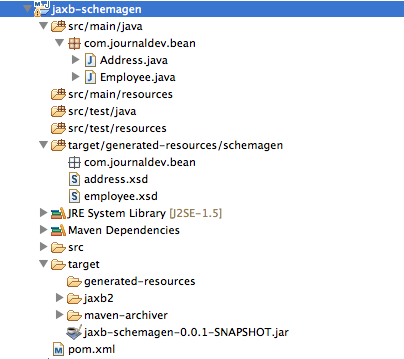在上几篇文章中,我们了解了JAVA JAXB以及如何从XSD](/community/tutorials/jaxb2-maven-plugin-xjc-example-generate-java-classes-xsd生成[Java类)。今天,我们将学习如何从Java类生成XSD。
从Java类生成XSD
 我们将在Maven项目中使用JAXB-2 Maven插件 从Java类生成XSD。
我们将在Maven项目中使用JAXB-2 Maven插件 从Java类生成XSD。
- JAXB2 Maven插件使用JAXB SchemaGenerator实用程序从Java类生成XSD。
- Java类应该有JAXB注释,以供此插件使用。
- 所需的最低Java版本为Java 5
首先创建一个新的maven项目,您可以给出您想要的任何名称、组ID和构件ID。一旦我们构建了我们的项目,它将在目标/生成的资源/方案目录中生成XSD类。建成后,我们的项目结构将如下图所示。 生成xsd这里是我们拥有的最后一个
生成xsd这里是我们拥有的最后一个pom.xml文件:
1<project xmlns="https://maven.apache.org/POM/4.0.0" xmlns:xsi="https://www.w3.org/2001/XMLSchema-instance"
2 xsi:schemaLocation="https://maven.apache.org/POM/4.0.0 https://maven.apache.org/xsd/maven-4.0.0.xsd">
3 <modelVersion>4.0.0</modelVersion>
4 <groupId>jaxb-schemagen</groupId>
5 <artifactId>jaxb-schemagen</artifactId>
6 <version>0.0.1-SNAPSHOT</version>
7 <dependencies>
8 <dependency>
9 <groupId>javax.xml.bind</groupId>
10 <artifactId>jaxb-api</artifactId>
11 <version>2.1</version>
12 </dependency>
13 </dependencies>
14
15 <build>
16 <pluginManagement>
17 <plugins>
18 <plugin>
19 <groupId>org.apache.maven.plugins</groupId>
20 <artifactId>maven-compiler-plugin</artifactId>
21 <version>2.5.1</version>
22 </plugin>
23 </plugins>
24 </pluginManagement>
25
26 <plugins>
27 <plugin>
28 <groupId>org.codehaus.mojo</groupId>
29 <artifactId>jaxb2-maven-plugin</artifactId>
30 <version>1.5</version>
31 <executions>
32 <execution>
33 <id>schemagen</id>
34 <goals>
35 <goal>schemagen</goal>
36 </goals>
37 </execution>
38 </executions>
39
40 <configuration>
41 <transformSchemas>
42 <transformSchema>
43 <uri>https://www.example.org/employee</uri>
44 <toPrefix>empns</toPrefix>
45 <toFile>employee.xsd</toFile>
46 </transformSchema>
47 <transformSchema>
48 <uri>https://www.example.org/address</uri>
49 <toPrefix>addrns</toPrefix>
50 <toFile>address.xsd</toFile>
51 </transformSchema>
52 </transformSchemas>
53 <includes>
54 <include>com/journaldev/bean/*</include>
55 </includes>
56 <verbose>true</verbose>
57
58 </configuration>
59 </plugin>
60 </plugins>
61 </build>
62</project>
需要注意的几点是jaxb依赖项、schemagen执行目标和transformSchema配置。transformSchema配置用于指定生成的XSD文件名和要在XSD文件中使用的命名空间前缀。下面是我们拥有的将用于生成XSD的Java类。关于我们
1package com.journaldev.bean;
2
3import javax.xml.bind.annotation.XmlAttribute;
4import javax.xml.bind.annotation.XmlType;
5
6@XmlType(namespace = "https://www.example.org/employee")
7public class Employee {
8 private String name;
9 private int id;
10 private String role;
11 private Address address;
12
13 public String getName() {
14 return name;
15 }
16
17 public void setName(String name) {
18 this.name = name;
19 }
20
21 @XmlAttribute
22 public int getId() {
23 return id;
24 }
25
26 public void setId(int id) {
27 this.id = id;
28 }
29
30 public String getRole() {
31 return role;
32 }
33
34 public void setRole(String role) {
35 this.role = role;
36 }
37
38 public Address getAddress() {
39 return address;
40 }
41
42 public void setAddress(Address address) {
43 this.address = address;
44 }
45}
注意,XmlType注释的命名空间用于类,XmlAttribute用于字段id。一旦我们构建了项目,这个类将生成employee.xsd模式。正如您所看到的,它有一个字段Address,这是另一个自定义类,因此我们还需要注释这个类以成功地生成模式。下面是带有jaxb注释的address类。Address.java
1package com.journaldev.bean;
2
3import javax.xml.bind.annotation.XmlType;
4
5@XmlType(namespace = "https://www.example.org/address")
6public class Address {
7 private String city;
8 private int zip;
9 private String addressLine1;
10 private String addressLine2;
11 public String getCity() {
12 return city;
13 }
14 public void setCity(String city) {
15 this.city = city;
16 }
17 public int getZip() {
18 return zip;
19 }
20 public void setZip(int zip) {
21 this.zip = zip;
22 }
23 public String getAddressLine1() {
24 return addressLine1;
25 }
26 public void setAddressLine1(String addressLine1) {
27 this.addressLine1 = addressLine1;
28 }
29 public String getAddressLine2() {
30 return addressLine2;
31 }
32 public void setAddressLine2(String addressLine2) {
33 this.addressLine2 = addressLine2;
34 }
35
36}
这个类将生成Address.xsd,因为它的名称在pom.xml文件的转换模式中匹配。我们的工程设置已经准备好了,只需使用mvn lean install命令构建工程,就会生成XSD文件。对于我的项目,生成的XSD文件如下所示。ployee.xsd
1<?xml version="1.0" encoding="UTF-8" standalone="yes"?>
2<xs:schema xmlns:xs="https://www.w3.org/2001/XMLSchema" xmlns:addrns="https://www.example.org/address" targetNamespace="https://www.example.org/employee" version="1.0">
3
4 <xs:import namespace="https://www.example.org/address" schemaLocation="address.xsd"/>
5
6 <xs:complexType name="employee">
7 <xs:sequence>
8 <xs:element minOccurs="0" name="address" type="ns1:address"/>
9 <xs:element minOccurs="0" name="name" type="xs:string"/>
10 <xs:element minOccurs="0" name="role" type="xs:string"/>
11 </xs:sequence>
12 <xs:attribute name="id" type="xs:int" use="required"/>
13 </xs:complexType>
14</xs:schema>
Address.xsd
1<?xml version="1.0" encoding="UTF-8" standalone="yes"?>
2<xs:schema xmlns:xs="https://www.w3.org/2001/XMLSchema" targetNamespace="https://www.example.org/address" version="1.0">
3
4 <xs:complexType name="address">
5 <xs:sequence>
6 <xs:element minOccurs="0" name="addressLine1" type="xs:string"/>
7 <xs:element minOccurs="0" name="addressLine2" type="xs:string"/>
8 <xs:element minOccurs="0" name="city" type="xs:string"/>
9 <xs:element name="zip" type="xs:int"/>
10 </xs:sequence>
11 </xs:complexType>
12</xs:schema>
这就是从Java类生成XSD的全部内容。对于Java类到XSD生成来说,这是一种非常简单而伟大的方式。我希望你会发现它是有用的,而且容易理解。